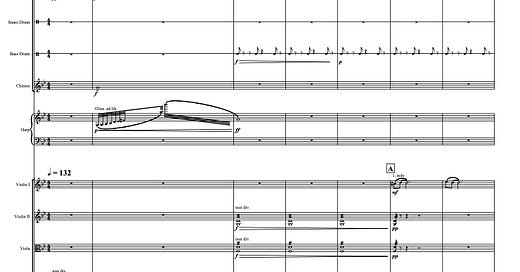FRESH: NewMusicUSA essay on my eight symphonic orchestrations of Duke Ellington, premiering at the end of the month at the Grange Festival. Gavin Sutherland will conduct the Bournemouth Symphony.
Read all about it. Special thanks to
Anthony Creamer (who first suggested a late Ellington project to me, and supplied recordings of all three Sacred Concerts)
Piers Playfair, the commissioner of Duke Ellington: From Stride to Strings
Tom Myron, my orchestral teacher and collaborator. I write in the essay, “Tom told me what orchestration books to read and answered key questions as I sat in front of my score for three months; eventually I spent a week at Tom’s house while we went through everything bar by bar. I didn’t argue, or at least I didn’t argue very much.”
The opening page of "Oclupaca"
the climax of "Loco Madi"
One runs across some oddities when surveying Duke’s work with outside forces. My jaw dropped open in shock when listening to “Non-Violent Integration” from The Symphonic Ellington. The first two choruses are perfect, Ellington, Sam Woodyard, and a truly fantastic bassist who died too soon, Ernie Shepard.
Then, an unnamed oboist from the Hamburg Symphony plays what might be the worst chorus of blues in the whole history of recorded Ellingtonia. (Starts at 43 seconds into the track.)
Johnny Hodges swoops in to save the day…but the humor isn’t done, for Jimmy Hamilton’s clarinet chorus takes the fluttering oboe idea and sort of fixes it, and Paul Gonsalves starts with a smeary quote of the ultimate Caucasian jazzy warhorse, “Rhapsody in Blue.” (?!) The orchestral backing is sometimes dissonant and “Third Stream” a la Gunther Schuller.
Is Duke and the band making fun of experimental white music? Under the title of “Non-Violent Integration??”
I can picture a scene in the studio where Duke smiles and tells the clueless cat, “Go ahead, Mr. Hamburg Oboe, we love you madly,” while the rest of the band makes fun of him behind his back.
John Howland’s book Ellington Uptown: Duke Ellington, James P. Johnson, and the Birth of Concert Jazz is helpful when considering projects that took place outside of the Ellington band. Howland confirms that every string arrangement was farmed out to collaborators like Luther Henderson, with the partial exception of what eventually became “Non-Violent Integration.”
Thanks to Howland for a great book… but Howland does call the Hamburg soloist “able,” which is not the word I would have chosen….




